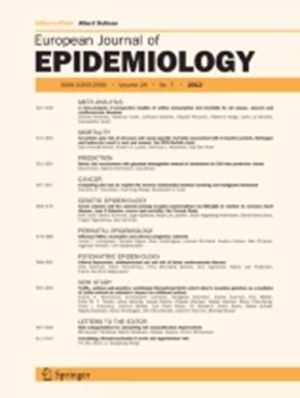Methods of estimating prevalence of multiple sclerosis in six European healthcare data sources: a contribution from the ConcePTION project.
IF 5.9
1区 医学
Q1 PUBLIC, ENVIRONMENTAL & OCCUPATIONAL HEALTH
引用次数: 0
Abstract
Multiple sclerosis (MS) is a chronic autoimmune condition primarily affecting women and often diagnosed during childbearing years. This study assessed the impact of the lookback period and calculation method on MS prevalence in three healthcare data sources including women of childbearing age (from Italy, Norway and Wales) and three data sources including pregnant women (from France, Finland and Spain). Women aged 15 to 49 years from 2005 to 2019 were included, data from pregnant women were collected around the pregnancy period. MS cases were identified based on at least one MS diagnosis or one dispensation for an MS-specific medication. All data sources provided inpatient diagnoses and medication data; outpatient diagnoses were available in Norway and Finland, and primary care diagnoses in Norway, Finland and Wales. We assessed MS case detection rate by lookback period, and compared three methods for estimating yearly MS prevalence: period prevalence (PP), average point prevalence (APP) and person-time prevalence (PTP). The estimated lookback periods to identify 95% of MS cases ranged from 6 to 9 years. APP and PTP provided lower prevalence estimates than PP, especially when the lookback to identify MS was short. In women of childbearing age, MS prevalence increased over time with all calculation methods and the highest MS prevalence was observed in Norway (PP of 402 per 100,000 in 2019). Finland showed the highest MS prevalence in pregnant women (PP of 218 per 100,000 in 2018). This study highlights the importance of sufficient lookback and available data to accurately estimate MS prevalence.估计六个欧洲医疗保健数据源中多发性硬化症患病率的方法:来自ConcePTION项目的贡献。
多发性硬化症(MS)是一种主要影响女性的慢性自身免疫性疾病,通常在育龄期被诊断出来。本研究评估了回顾期和计算方法对育龄妇女(意大利、挪威和威尔士)和孕妇(法国、芬兰和西班牙)三个医疗数据来源中MS患病率的影响。从2005年到2019年,年龄在15岁到49岁之间的女性被纳入其中,孕妇的数据在怀孕期间收集。多发性硬化症病例是根据至少一次多发性硬化症诊断或一次多发性硬化症特异性药物的分配来确定的。所有数据来源均提供住院诊断和用药数据;在挪威和芬兰有门诊诊断,在挪威、芬兰和威尔士有初级保健诊断。我们通过回顾期评估MS病例检出率,并比较了三种估计MS年患病率的方法:期患病率(PP)、平均点患病率(APP)和个人时间患病率(PTP)。估计95%的多发性硬化症病例的回顾期为6至9年。APP和PTP提供的患病率估计值低于PP,特别是当回顾识别MS的时间较短时。在育龄妇女中,所有计算方法的多发性硬化症患病率都随着时间的推移而增加,挪威的多发性硬化症患病率最高(2019年为每10万人402例)。芬兰孕妇的多发性硬化症患病率最高(2018年每10万人中有218人患病)。这项研究强调了足够的回顾和可用数据对准确估计MS患病率的重要性。
本文章由计算机程序翻译,如有差异,请以英文原文为准。
求助全文
约1分钟内获得全文
求助全文
来源期刊

European Journal of Epidemiology
医学-公共卫生、环境卫生与职业卫生
CiteScore
21.40
自引率
1.50%
发文量
109
审稿时长
6-12 weeks
期刊介绍:
The European Journal of Epidemiology, established in 1985, is a peer-reviewed publication that provides a platform for discussions on epidemiology in its broadest sense. It covers various aspects of epidemiologic research and statistical methods. The journal facilitates communication between researchers, educators, and practitioners in epidemiology, including those in clinical and community medicine. Contributions from diverse fields such as public health, preventive medicine, clinical medicine, health economics, and computational biology and data science, in relation to health and disease, are encouraged. While accepting submissions from all over the world, the journal particularly emphasizes European topics relevant to epidemiology. The published articles consist of empirical research findings, developments in methodology, and opinion pieces.
 求助内容:
求助内容: 应助结果提醒方式:
应助结果提醒方式:


